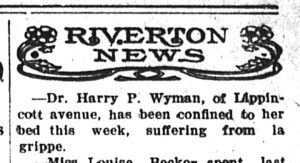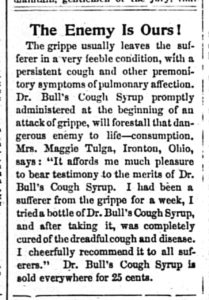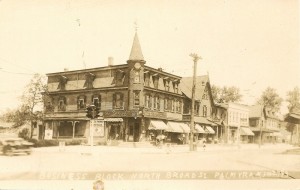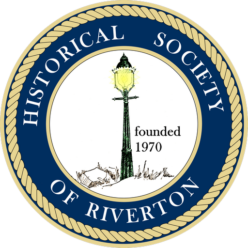It is known by many names: la grippe, grip, grippe, plague, influenza, or informally, the “flu.” Since ancient times influenza has struck human populations. Thought then to be spread more by celestial influence than by inhaling flu viruses as we know today, the word influenza comes the Latin influentia, meaning “influence of the stars.”

The flu strain this year seems to have involved most of the country, according to the Center for Disease Control’s Weekly US Map: Influenza Summary Update.
The severity of flu seasons varies, but certainly one of the worst was the Influenza Pandemic of 1918-1919. History.com describes the outbreak as:
… the deadliest in modern history, infected an estimated 500 million people worldwide–about one-third of the planet’s population at the time–and killed an estimated 20 million to 50 million victims.


A century ago, when the flu laid low inhabitants of Riverton and Palmyra, news of their plight spread in the local newspapers.
Years earlier, Palmyra’s Weekly News reported in February 1897, at least nine instances of influenza, grip, or pneumonia.

In 1901, a Bridgeton paper reported, “One-third of the population of Riverton and Palmyra are suffering from the effects or just recovering from the grip.”

Long before the invention of a flu vaccine in 1938, some folks around here depended upon sarsaparilla or Dr. Bull’s Cough Syrup for symptom relief.

Palmyra Rexall Pharmacy sold its own proprietary remedy, Creighton’s Grippe Capsule.

During the flu season of 1916, Riverton Free Library remained closed for six weeks to cut the spread of the disease.
(More recently, Riverton Public School shut down for a few days in January 1985 because of the flu.)
Last January’s post on phillyvoice.com, Philadelphia was epicenter of a deadly worldwide flu epidemic 99 years ago, pins part of the blame for what made the flu so devastating, especially in Philadelphia, on a September 28, 1918 event when sailors and soldiers returning from overseas mixed among citizens who turned out for a Liberty Loan Drive parade on Broad Street.
Perhaps it was during the later outbreak that Mrs. James T. Weart of Palmyra volunteered to serve with the Red Cross as a nurse at Ft. Dix.
Possibly, more family stories can tell of a local connection to the 1918-1919 influenza pandemic. -JMc
For more perspective on the 1918 flu epidemic, see:
https://www.archives.gov/exhibits/influenza-epidemic/
https://www.smithsonianmag.com/history/journal-plague-year-180965222/
https://news.nationalgeographic.com/news/2014/04/140428-1918-flu-avian-swine-science-health-science/
http://www.pbs.org/wgbh/americanexperience/films/influenza/

Of the six World War I Riverton Gold Star boys who died serving their country, two contracted influenza and died after a short but deadly outbreak in 1918 — Raymond Pratt and Charles Kelly. Still a terrible disease.